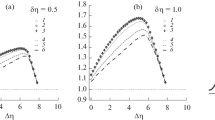Abstract
The strongly intensive observable between multiplicities in two acceptance windows separated in rapidity is calculated in the model with quark-gluon strings acting as particle emitting sources. The dependence of this observable on the two-particle correlation function of a string, the width of observation windows and the rapidity gap between them is presented. String fusion effects violate the property of strong intensity. Changes in the behaviour of this observable with energy and collision centrality, arising due to the string fusion phenomena, are discussed. Predictions for the NICA collision energy range are presented.



Similar content being viewed by others
REFERENCES
M. I. Gorenstein and M. Gazdzicki, “Strongly intensive quantities,” Phys. Rec. C 84, 014904 (2011).
E. V. Andronov, “Influence of the quark-gluon string fusion mechanism on long-range rapidity correlations and fluctuations,” Theor. Math. Phys. 185, 1383–1390 (2015).
A. Bialas and W. Czyz, “Conversion of color field into Q \(\bar {Q}\) matter in the central region of high-energy heavy ion collisions,” Nucl. Phys. B 267, 242–252 (1986).
M. A. Braun and C. Pajares, “Particle production in nuclear collisions and string interactions,” Phys. Lett. B 287, 154–158 (1992).
E. Andronov and V. Vechernin, “Strongly intensive observable between multiplicities in two acceptance windows in a string model,” Eur. Phys. J. A 55, 14 (2019).
V. Vechernin, “Forward-backward correlations between multiplicities in windows separated in azimuth and rapidity,” Nucl. Phys. A 939, 21–45 (2015).
S. N. Belokurova and V. V. Vechernin, “Strongly intensive variables and long-range correlations in the model with a lattice in the transverse plane,” Theor. Math. Phys. 200, 1094–1109 (2019).
I. Sputowska (for the ALICE Collab.), “Forward-backward correlations and multiplicity fluctuations in Pb-Pb collisions at \(\sqrt {{{s}_{{{\text{NN}}}}}} \) = 2.76 TeV from ALICE at the LHC,” MDPI Proc. 10, 14 (2019).
V. Kovalenko, “Strongly intensive fluctuations and correlations in ultrarelativistic nuclear collisions in the model with string fusion,” EPJ Web Conf. 204, 03006 (2019).
D. Prokhorova (for the NA61/SHINE Collab.), “Pseudorapidity dependence of multiplicity and transverse momentum fluctuations at the SPS energies,” EPJ Web Conf. 204, 07013 (2019).
E. Andronov (for the NA61/SHINE Collab.), “N–N, PT–N and PT–PT fluctuations in nucleus-nucleus collisions at the NA61/SHINE experiment,” KnE Energ. Phys. 3, 226–233 (2018).
J. Weil, V. Steinberg, J. Staudenmaier, L. G. Pang, D. Oliinychenko, J. Mohs, M. Kretz, T. Kehrenberg, A. Goldschmidt, B. Bäuchle, J. Auvinen, M. Attems, and H. Petersen, “Particle production and equilibrium properties within a new hadron transport approach for heavy-ion collisions,” Phys. Rec. C 94, 054905 (2016).
M. Meres, I. Melo, B. Tomasik, V. Balek, and V. Cerny, “Generating heavy particles with energy and momentum conservation,” Comput. Phys. Commun. 182, 2561–2566 (2011).
Funding
This study was funded by RFBR according to the research project no. 18-02-40097.
Author information
Authors and Affiliations
Corresponding authors
Ethics declarations
The authors declare that they have no conflict of interest.
Rights and permissions
About this article
Cite this article
Andronov, E., Vechernin, V. Multiplicity Correlations with Strongly Intensive Quantities. Phys. Part. Nuclei 51, 337–339 (2020). https://doi.org/10.1134/S106377962003003X
Received:
Revised:
Accepted:
Published:
Issue Date:
DOI: https://doi.org/10.1134/S106377962003003X



